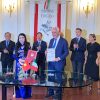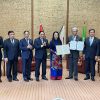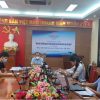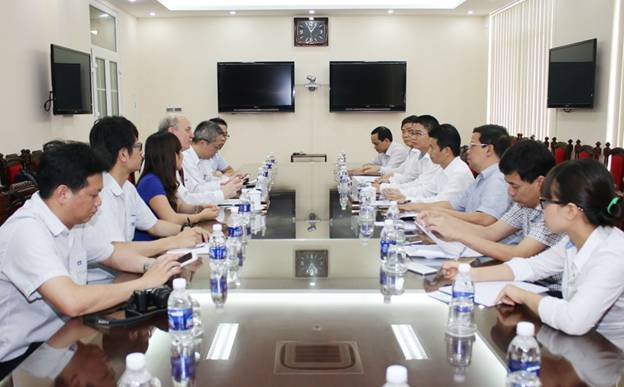Policies in effect as of November, 2016 (Part 3)

- New regulations on management, use and depreciation of fixed assets
On 13 October 2016, the Ministry of Finance issued Circular No. 147/2016/TT-BTC on amending, supplementing to a number of articles of Circular No. 45/2013/TT-BTC on management, use and depreciation of fixed assets
Accordingly, the Circular has the following notable regulations:
– Fixed assets for rent and for sale are not allowed to be depreciated.
– For combined houses which are not only used as operating assets of enterprises but also for sale, lease, the enterprises must determine and separate the houses’ area used for sale, lease. The operating assets of enterprises is either recorded as fixed assets or depreciated.
In case an enterprise cannot determine, separate the houses’ area used for sale, lease, the whole value of such combined houses shall not be recorded as fixed assets and depreciated.
Tangible fixed assets shall be classified as follows:
Type 1: Housing and structures: are the enterprise’s fixed assets formed after the construction process, such as office, warehousing, fences, water towers, open storages, house-decorating works, roads, bridges, railways, airfields, piers, wharves, docks and slipways.
Type 2: Machinery and equipments: are the whole machinery and equipments used in the operation of the enterprise such as specialized machinery, working equipment, drilling rigs used in the section of oil and gas, cranes, technology lines and separate machines.
Type 3: Means of transport, transmission equipment: are types of means of transportation including railways, water ways, roads, airways, pipeline and transmission equipment like information systems, electricity systems, plumbing, conveyors, air ducts.
Type 4: Management equipment and tools: are equipment and tools used in the management of the operation of the enterprise such as computers serving the management, electronic equipment, equipment and tools for measurement and quality inspection, dehumidifiers, vacuum cleaners, anti-termite machines.
Type 5: Perennial orchards, animals performing tasks and/or giving products: includes perennial orchards like coffee plantations, tea plantations, rubber plantations, orchards, lawns, green carpets, etc.; animals performing tasks and/or giving products like elephant, horse, buffalo, bovine animals, etc.
Type 6: Fixed assets being infrastructural works with high value which are invested by the State budget and allocated to economic organizations for management, development and use.
Type 7: Other fixed assets: are all of other fixed assets which have not been classified into the above-mentioned types.
The Circular regulates that the State-invested fixed assets (fixed assets of the 6th categories specified in item 2 of Article 1) are not depreciated. Their liquidation or sale must be approved in writing by the State ownership representative and the proceeds shall be submitted into the state budget.
This Circular takes effect from 28 November 2016 and applies from the fiscal year 2016.
- Guidance on the initial sale of shares of wholly state-owned enterprises
As from 01 November 2016, the Circular No. 115/2016/TT-BTC amending the Circular No.196/2011/TT-BTC on the initial sale of shares of wholly state-owned enterprises (SOE) shall take effect. Whereby:
– When an equitized enterprise registers the initial offering through the Stock Exchange, it must apply for registration, depository and registration of share trading at the same time.
– Within ten (10) working days from the deadline for making payment for the shares sold at auction, the equitized enterprise must report to the State Securities Committee of Vietnam and publish information on result of offering of shares.
The result of offering of shares must be attached to the certification of the commercial bank where the escrow account of proceeds from the auction is opened.
The Equitization Steering Committee shall sign a contract or authorize the equitized enterprise to sign an auctioneering service contract with the Organization which carries out the auction of shares
- Abolition of the Circular No.37/2015/TT-BCT of the Minister of Industry and Trade
The Minister of Industry and Trade issues the Circular No. 23/2016/TT-BCT on abolition of the Circular No.37/2015/TT-BCT dated October 30, 2015 specifying regulation on limits and inspection of content of formaldehyde and aromatic amines derived from azo colorants in textile products.
This Circular takes effect as from 26 November 2016.
- The Circular No. 20/2016/TT-BCT regulating the quota on energy consumption of the following processes of production in the steel industry for the period that extends to the year of 2020 inclusive and the period that extends from 2021 to 2025 inclusive: Sintering of iron ore; iron making by blast furnace, steelmaking by (top-blown) converter, steelmaking by electric arc furnace, steelmaking by induction furnace; steel rolling.
In particular, the quota on energy consumption of the steel industry for the period that extends to 2020 and for the period that extends from 2021 to 2025 is respectively as follows: Sintering of iron ore 2,350 MJ/tone and 1,960 MJ/tone; Production of cast iron by blast furnace: 14,000 MJ/tone and 12,400 MJ/tone; Production of steel billet by (top-blown) converter: 150 MJ/tone and 100 MJ/tone; Production of steel billet by electric arc furnace 2,600 MJ/tone and 2,500 MJ/tone; Production of steel billet by induction furnace: 2,600 MJ/tone and 2,500 MJ/tone; Hot rolling of long steel products: 1,650 MJ/tone and 1,600 MJ/tone; Cold rolling of steel plates: 1,650 MJ/tone and 1,600 MJ/tone.
The Circular requires the compliance with the quota on energy consumption for the period extending to 2025: The specific energy consumption of a producer in the steel industry shall not exceed the quota on above-mentioned energy consumption. If the energy consumption exceeds the quota on energy consumption in a corresponding period, such producer must formulate and adopt solutions that heighten the efficiency in the use of energy so as to conforming to this Circular. The specific energy consumption (SEC) of a new investment project or an expansion project shall not exceed the SEC of period of 2021-2025.
Besides, the Circular also provide certain solutions for enhancing the energy consumption efficiency of the steel industry, including: The establishment of the IS 50.001 energy management system and elevation of the energy consumption efficiency; Solutions for heightening the low-investment energy efficiency (by replacing with separate apparatus with a higher energy consumption performance); Solutions for heightening the high-investment energy efficiency (by replacing with the equipment or clusters of equipment with a higher energy consumption performance or with other technologies); Encouragement to adopt the energy productivity enhancement solutions indicated in this Circular.
Circular No. 20/2016/QD-BCT takes effect as of 08 November 2016.
- Regulations on e-procedures for boats, ships’ entry, exit from seaports, inland ports, and offshore oil ports via national single-window system
The Prime Minister has promulgated the Decision No. 34/2016/QD-TTg stipulating e-procedures for boats, ships’ entry, exit from seaports, inland ports, offshore oil ports via national single-window system. It takes effect as of 15 November 2016. In which, the highlights are:
- E-documents, conversion from paper documents into e-documents and vice versa
According to this Decision, e-documents declared or shown to professional regulators at ports through National single-window system may be converted from paper documents if meeting following requirements:
– Reflecting all the information from paper documents.
– Ensuring availability of a digital signature registered with NSW portal.
Paper documents may be converted from e-documents provided through NSW portal if meeting following requirements:
– Reflecting all the information from e-documents.
– Bearing signs to notice that they are converted from e-documents and printed from NSW portal.
– Bear legal signature, full name and seal of the declarant.
- E-procedures for domestic and foreign boats, ships’ entry into seaports, inland ports
– The decision stipulates documents to be declared in the electronic form through NSW portal and those to be presented to regulators.
– Professional regulators shall be responsible for inspecting documents and handling procedures.
E-permits shall be implemented as follows: Two hours at the latest since receipt of notice of arrival of ships at the pilot boarding area, port authorities shall issue dispatch instruction through NSW portal; One hour at the latest since the declarant completes declaration and dispatch of e-applications as prescribed, port authorities shall issue written confirmations of the completion of the procedures to the declarant.
Additionally, this Decision stipulates e-procedures for: Vietnamese and foreign boats, ships’ exit from seaports, inland ports; Foreign ships making transit; Boats, ships’ entry into or exit from offshore oil ports; Inland waterway boats, ships’ entry into or exit from seaports, inland ports; Vietnamese and Cambodian inland watercraft’s entry into or exit from Vietnamese seaports, inland ports.
- Operation of National single-window system
– The General Department of Customs shall be responsible for ensuring 24/7 operation of NSW portal. NSW portal shall be connected to the information system of General Department of Customs and the ministries’ professional information systems.
– Professional regulators at ports shall be responsible to ensure 24/7 operation of professional information systems connected to NSW portal.
- The expansion of Lao Cai Border Gate Economic Zone
The Prime Minister has issued Decision No. 40/2016/QD-TTg on expanding Lao Cai border-gate economic zone in Lao Cai Province.
Accordingly, Lao Cai border gate economic zone has the geographical boundaries belongs to national sovereignty with a separate economic space. After expanded, it has total area of 15,929.8 ha.
It is organized with functional areas including: non-tariff zone; gate zone; industrial parks and handicraft zone; entertainment and tourism areas, urban areas, residential and other functional areas which are consistent with the provisions of law and local characteristics. The size and position of each functional area is defined in the general construction planning, zoning planning and detailed planning of Lao Cai border-gate economic zone.
The economic zone is operated under the current provisions of law on economic, border gate economic zone and relevant legal policies. The assurance of business investment for the case of geographical boundary changes as mentioned in this Decision shall be done in compliance with Article 13 of Law on Investment 2014 and Article 3 of Decree No. 118/2015/ND-CP dated 12 November 2015.
This Decision takes effect as of 15 November 2016.
Other news
- Seminar of investment cooperation between Vinh Phuc and Tuscany, Italy
- Report of Japan Desk’s activities in the first 06 months of 2021
- Deputy President of the Provincial People’s Committee, Mr. Vu Chi Giang at the Weekly Business Meeting Program
- Ms. Hoang Thi Thuy Lan, Secretary of the Provincial Party Committee working with Toyota Motor Vietnam Co., Ltd and Honda Vietnam Co.,Ltd
- The seminar “Businesses ask – Government answers” creating favorable conditions for economic recovery from Covid-19 epidemic




